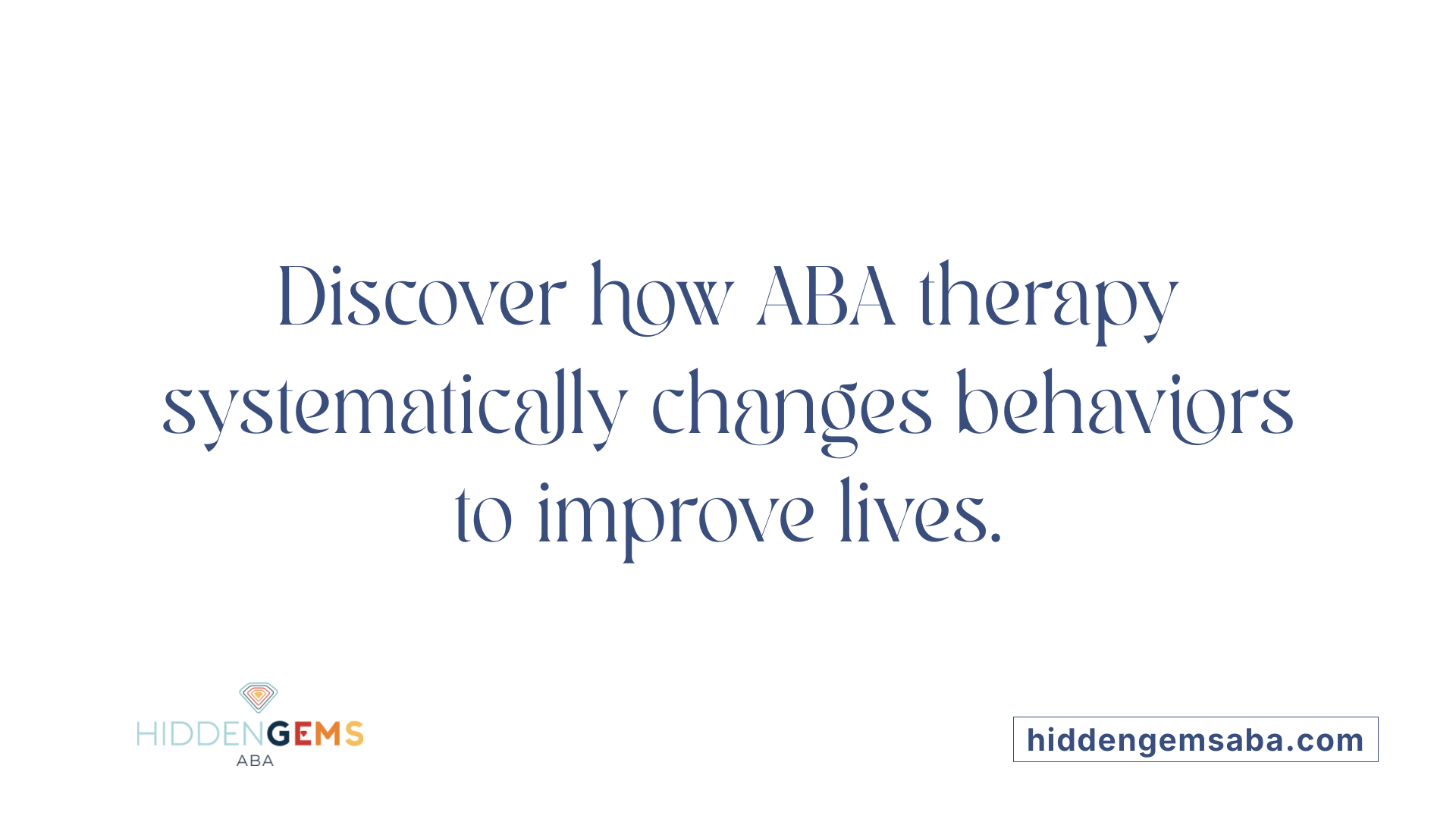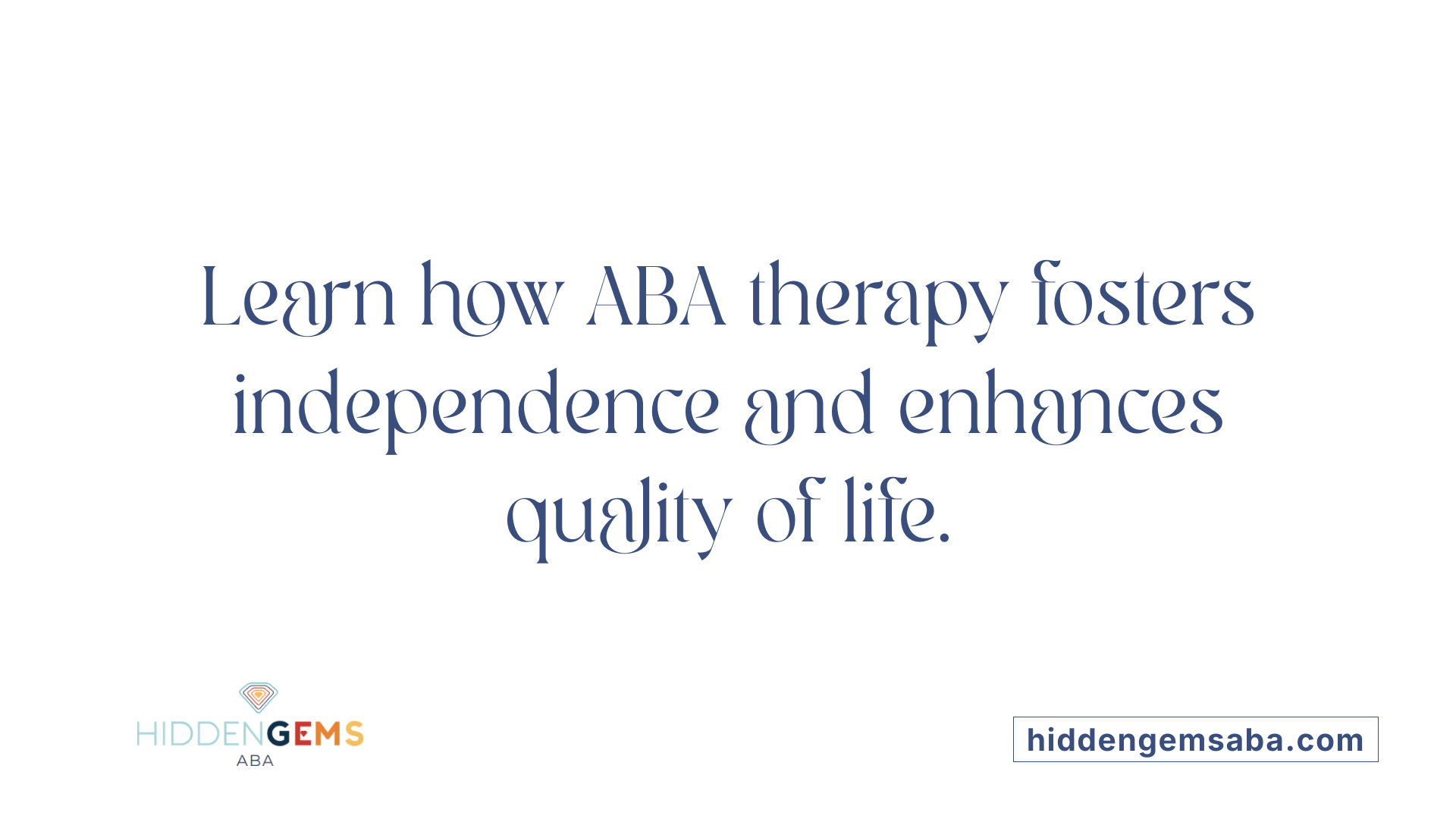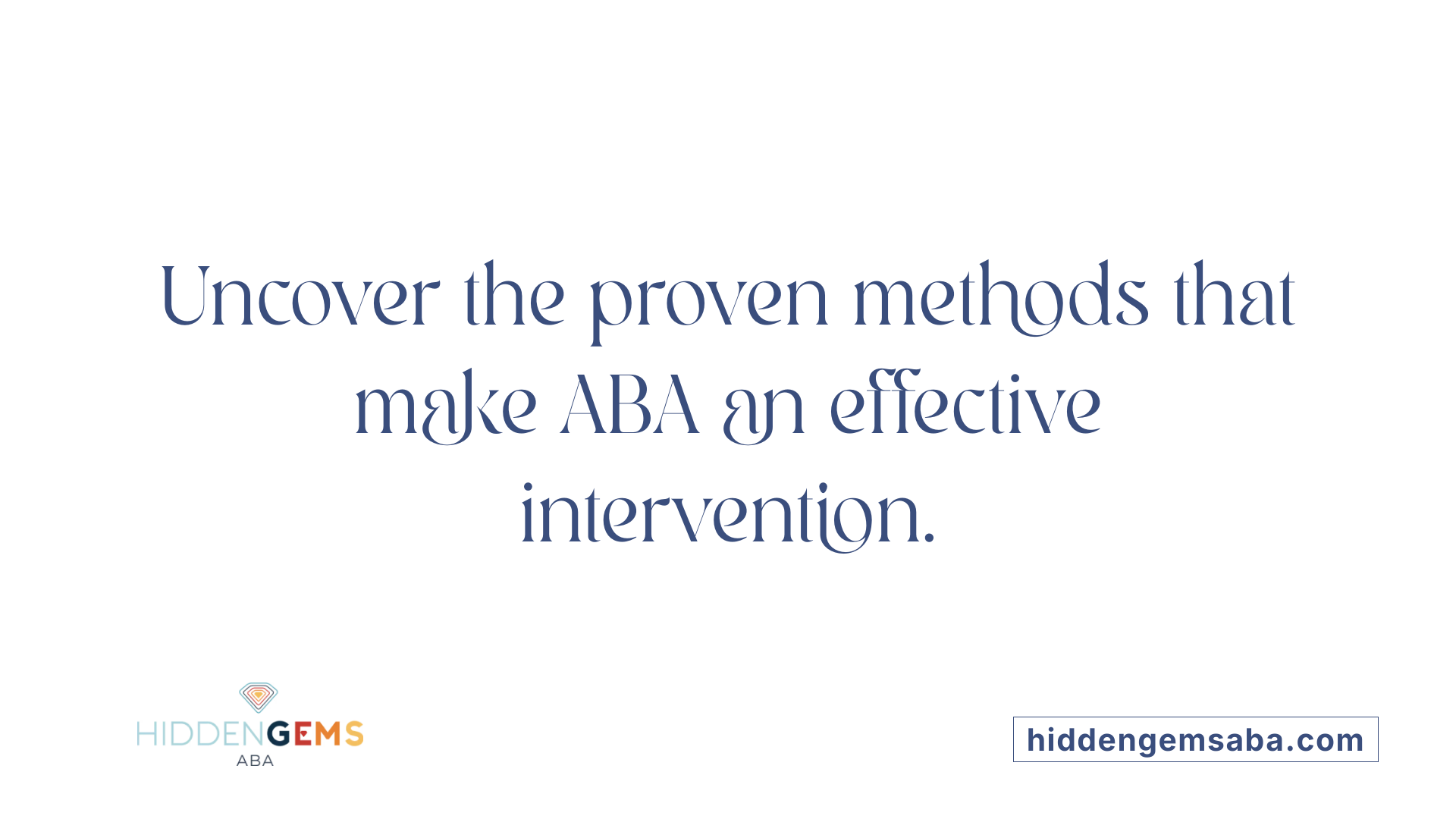Understanding ABA Therapy and Its Impact
Applied Behavior Analysis (ABA) has established itself as a cornerstone in the treatment of behavioral disorders, particularly autism spectrum disorder (ASD). Rooted in scientific principles, ABA employs systematic techniques to effect positive changes in behavior, social skills, communication, and daily functioning. This article explores the fundamentals, applications, benefits, controversies, and access points of ABA therapy, providing a comprehensive guide for those seeking effective behavioral interventions.
What is ABA therapy and how does it work?

What is ABA therapy and how does it work?
Applied Behavior Analysis (ABA) is a scientific approach that focuses on understanding and changing behavior through the influences of the environment. It is widely recognized as an effective method for addressing developmental challenges, especially autism spectrum disorder.
ABA works by using proven strategies like positive reinforcement, prompting, modeling, and chaining behaviors. Positive reinforcement, for example, involves rewarding desirable behaviors to encourage repetition. Therapists also assess environmental triggers—what happens before a behavior (antecedents) and what follows afterward (consequences)—to understand why certain behaviors occur.
Practitioners develop personalized treatment plans based on thorough assessments. These plans include specific goals related to communication, social skills, daily living, and reducing harmful behaviors like self-injury or tantrums. Data collection is an ongoing part of ABA, with therapists regularly monitoring progress through charts and measurements. This systematic tracking helps in adjusting strategies for better outcomes.
ABA interventions are flexible and can be applied in various settings such as at home, in school, clinics, or in the community. By targeting socially meaningful behaviors and promoting independence, ABA aims to significantly improve individuals' quality of life.
Overall, ABA combines scientific principles with individualized care to facilitate meaningful behavior change, ensuring that interventions are effective, relevant, and respectful of each person’s unique needs.
Conditions treated with ABA therapy

What conditions are treated with ABA therapy?
Applied behavior analysis (ABA) is most widely recognized for its effectiveness in treating autism spectrum disorder (ASD). However, its applications extend to a variety of other developmental and behavioral challenges. ABA therapy can help children and some adults develop essential skills and manage problematic behaviors.
When it comes to autism, ABA addresses core difficulties such as speech delays, social skill deficits, attention problems, and sensory sensitivities. By reinforcing adaptive behaviors and decreasing harmful ones, ABA can significantly improve quality of life.
Beyond ASD, ABA is also used for developmental delays and disorders such as intellectual disabilities, sensory processing issues, and motor skill impairments. Children with speech and language delays, self-care difficulties, or those who exhibit challenging behaviors like aggression or self-injury can benefit from tailored ABA programs.
The therapy is adaptable, making it suitable for other conditions such as Attention Deficit Hyperactivity Disorder (ADHD), obsessive-compulsive disorder (OCD), and Pervasive Developmental Disorder-Not Otherwise Specified (PDD-NOS). It can also assist with behaviors associated with Down syndrome, apraxia, food selectivity, and other sensory processing challenges.
Overall, ABA’s versatility makes it a valuable intervention for a broad spectrum of conditions. Its personalized approach helps individuals build learned skills, improve social interactions, and reduce disruptive behaviors, supporting their independence and participation in daily life.
| Condition | Focus Areas | Typical Goals | Additional Details |
|---|---|---|---|
| Autism Spectrum Disorder (ASD) | Communication, social skills, adaptive behaviors | Language development, social interaction, self-regulation | Most common and extensively studied use of ABA |
| Developmental delays | Motor, speech, social skills | Basic self-care, play skills, communication | Tailored to individual developmental levels |
| Behavioral challenges | Aggression, self-injury, tantrums | Reduce harmful behaviors, teach coping skills | Techniques involve reinforcement and environmental modifications |
| ADHD, OCD, PDD-NOS | Attention, impulse control, compulsions | Focus improvement, reduce compulsive behaviors | Often combined with other therapies like occupational or speech therapy |
| Down syndrome, sensory processing issues | Motor skills, sensory integration | Improve coordination, reduce sensory overload | Helps in promoting independence and safety in daily routines |
This broad applicability underscores ABA’s effectiveness across various diagnoses, emphasizing individualized, evidence-based treatment for improved functioning and life quality.
The benefits of ABA therapy
 ABA therapy provides many positive outcomes for children with autism and other developmental challenges. It significantly improves social skills, communication, and the ability to learn new activities. Scientific research supports its effectiveness in helping children develop language, increase engagement in learning, and enhance social interactions.
ABA therapy provides many positive outcomes for children with autism and other developmental challenges. It significantly improves social skills, communication, and the ability to learn new activities. Scientific research supports its effectiveness in helping children develop language, increase engagement in learning, and enhance social interactions.
Early intervention with intensive ABA—often involving more than 20 hours a week during a child's early years—can lead to substantial developmental improvements. Children receiving early, consistent ABA therapy tend to show larger gains in milestones such as language development, self-care, and independence. These early efforts can even reduce the need for additional special services later in life.
One of the standout qualities of ABA is its tailored approach. Each treatment plan is personalized based on the child’s specific needs, strengths, and goals. Professionals like board-certified behavior analysts work closely with families to design programs that include clear objectives, regular assessments, and progress monitoring.
Family involvement is highly encouraged, allowing parents and caregivers to participate actively in therapy sessions and learn strategies to reinforce skills at home. This collaboration helps create consistent learning environments and supports the child’s ongoing development.
The ultimate goal of ABA is to foster independence and improve everyday functioning. Children learn to transfer their skills across different settings and situations, which enhances their ability to participate fully in social activities, school, and community life. Overall, ABA therapy helps children build essential skills that contribute to a better quality of life and greater self-reliance.
Key techniques used in ABA therapy
 Applied Behavior Analysis (ABA) employs a variety of targeted techniques to teach new skills and reduce problematic behaviors. Understanding these methods can give insight into how ABA interventions are personalized to meet individual needs.
Applied Behavior Analysis (ABA) employs a variety of targeted techniques to teach new skills and reduce problematic behaviors. Understanding these methods can give insight into how ABA interventions are personalized to meet individual needs.
One foundational technique is Discrete Trial Training (DTT). This structured approach involves breaking down skills into small, manageable steps and teaching them through repeated, clear trials. During DTT, a therapist presents a cue or instruction, waits for the individual to respond, and then provides reinforcement or correction based on the response.
Positive reinforcement strategies form the backbone of ABA. When a desired behavior occurs, it is immediately rewarded with praise, tokens, or other preferred stimuli. This encourages the individual to repeat the behavior in future situations. Reinforcement can be tailored to what motivates each person, making it a flexible and effective strategy.
Modeling and imitation are also central techniques. Therapists or videos demonstrate desired behaviors, which individuals are encouraged to imitate. This method leverages observational learning to teach social and functional skills, with imitation considered a stepping stone toward independent behavior.
Prompting and fading are used to guide learners through tasks. Prompting involves giving cues—such as physical guidance or verbal hints—to encourage correct responses. Over time, prompts are gradually reduced, or faded, to foster independence, ensuring that the individual performs the skill without assistance.
Natural environment teaching (NET) focuses on learning in real-world settings. Skills are embedded within the individual’s daily routines and interactions, promoting generalization. For example, a child might learn requesting items during play or snack time, making the skills more relevant and functional.
Additional methods like task analysis break complex skills into smaller steps, while social stories and visual supports help teach social norms and reduce anxiety around unfamiliar situations. By combining these techniques, ABA can be highly personalized, targeting communication, social skills, daily living, and behavioral goals.
In summary, ABA's effectiveness relies on the strategic application of these techniques, which are adapted to suit each person's strengths and challenges, ultimately fostering meaningful progress in multiple areas of development.
Controversies and myths surrounding ABA

Are there controversies or myths surrounding ABA therapy?
Applied behavior analysis (ABA) has long been regarded as a scientifically validated approach for helping children with autism develop essential skills and reduce problematic behaviors. However, it has not been free from criticism and misconceptions.
Historically, some of the controversy surrounding ABA arises from its early use of aversive techniques in the 1960s and 1970s. Methods such as electric shocks and other punitive approaches were once employed to discourage harmful behaviors. These practices are now widely considered unethical and are no longer part of modern ABA therapy, which emphasizes positive reinforcement and individualized, compassionate interventions.
Another common myth is that ABA aims to make children conform to neurotypical standards at the expense of their natural behaviors and identities. Critics argue that traditional ABA’s structured and repetitive nature can be stressful or overwhelming for some children. Concerns have been raised that it might focus excessively on eliminating behaviors like stimming, which many view as a natural expression of neurodiversity.
Despite these criticisms, current ABA practices have evolved significantly. Now, they prioritize ethical standards, respect for neurodiversity, and person-centered approaches. Naturalistic teaching techniques, such as the Early Start Denver Model (ESDM) and Pivotal Response Treatment (PRT), promote learning in more relaxed and engaging environments, often embedded in play.
Implementing ABA involves ongoing assessments, personalized goals, and close collaboration with families. It aims to build skills that support independence and societal participation, while respecting individual differences and preferences.
Challenges remain, including the stress that highly structured programs can place on some children. This has led to ongoing efforts to improve ethical standards and develop less intensive, more naturalistic approaches.
Modern ABA practitioners are committed to ethical improvements, including avoiding punitive practices and prioritizing the child's well-being. Many now include goals that honor natural behaviors, self-expression, and individual strengths.
In summary, while some myths and controversies persist, the field has shifted towards compassionate, respectful, and evidence-based practices. The goal remains to support individuals' growth and independence without compromising their dignity or identity.
Differentiating ABA from other treatment approaches
How does ABA therapy differ from other approaches like cognitive-behavioral therapy (CBT)?
Applied Behavior Analysis (ABA) and Cognitive Behavioral Therapy (CBT) are both evidence-based psychological approaches but have distinct focuses and methods.
ABA primarily concentrates on observable behaviors. Therapists use scientific techniques to analyze, modify, and reinforce behaviors through systematic assessment, data collection, and personalized intervention plans. Its main goal is to increase helpful behaviors such as communication, social skills, and daily living habits, while reducing harmful behaviors like self-injury or aggression.
CBT, on the other hand, emphasizes understanding and changing internal thought patterns to influence emotions and behaviors. It involves structured talk therapy sessions where individuals explore their feelings and beliefs, learning strategies to manage anxiety, depression, or emotional dysregulation.
While ABA often targets children with autism and developmental challenges, CBT is frequently used for both children and adults dealing with mental health conditions such as anxiety, depression, OCD, and trauma.
Although their methods differ, ABA and CBT can complement each other. ABA focuses on external behavior change through reinforcement and environmental adjustments, whereas CBT addresses internal emotional and cognitive processes. Together, they can provide a comprehensive approach tailored to individual needs.
In summary, ABA’s scientific approach is centered on observable behaviors and reinforcement strategies, primarily used in autism intervention, while CBT works on internal thoughts and emotions, applicable to a wider range of mental health issues.
Accessing ABA therapy and safety considerations
How can I find and choose providers?
Finding a qualified ABA provider involves researching credentialed professionals such as board-certified behavior analysts (BCBAs) and trained therapists like Registered Behavior Technicians (RBTs). Families can start by contacting reputable organizations such as Autism Speaks or visiting state health department resources. It’s essential to verify that providers are licensed or certified according to local regulations, and have experience working with children with autism or developmental disorders.
Choosing the right provider also includes considering the therapy setting, approach, and rapport with the child. Providers offering personalized, evidence-based programs that incorporate naturalistic and play-based techniques—such as PRT or ESDM—are often preferable. Families should feel comfortable participating in sessions, providing input, and seeing ongoing progress.
What about insurance coverage and financial aspects?
Insurance policies vary, but many now cover ABA therapy if it is deemed medically necessary, especially for children diagnosed with autism. Families should check with their insurance provider to understand coverage limits, required documentation, and pre-authorization procedures. Medicaid programs in states like Texas often cover ABA services for eligible children. When private insurance doesn’t fully cover the costs, families may explore options such as sliding scale payments, scholarships, or financial assistance programs.
Safety and ethical practices are crucial points to consider. The Behavior Analyst Certification Board (BACB) provides ethical guidelines that ensure proper, respectful, and science-based care. Behavior analysts and RBTs must prioritize safety, obtain informed consent, and tailor interventions to each child's unique needs. Ethical practice involves maintaining confidentiality, respecting neurodiversity, and avoiding harmful or coercive methods.
Families also play an important role in ongoing monitoring. Participating in sessions, tracking progress, and communicating regularly with providers help ensure interventions remain appropriate and effective. They should also be vigilant about treatment methods, avoiding approaches that rely heavily on punishment or punishment-based techniques, which are not aligned with current ethical standards.
In summary, accessing ABA services involves researching qualified providers, understanding insurance options, and ensuring safety and ethics are prioritized throughout the process. Active family involvement and continuous evaluation support successful and ethical therapy experiences for children.
Summary and Future Perspectives in ABA Therapy
ABA therapy remains a scientifically validated, versatile approach to addressing behavioral challenges, especially in autism spectrum disorder. Its methods, founded on learning principles, continue to evolve towards more naturalistic, person-centered, and inclusive practices. While controversies exist, ongoing research and professional ethical standards aim to improve its effectiveness and respect for neurodiversity. Families, practitioners, and policymakers are encouraged to understand ABA’s full potential and access resources to support individuals on their behavioral development journey, ultimately fostering greater independence, social integration, and quality of life.
References
- Applied Behavior Analysis (ABA) - Cleveland Clinic
- Applied Behavior Analysis (ABA) | Autism Speaks
- Applied Behavior Analysis: What Is It and How Does It Work? - WebMD
- The Controversy Around ABA - Child Mind Institute
- What Conditions Are Treated With ABA Therapy?
- Treatment and Intervention for Autism Spectrum Disorder - CDC
- Applied Behavior Analysis - Psychology Today






